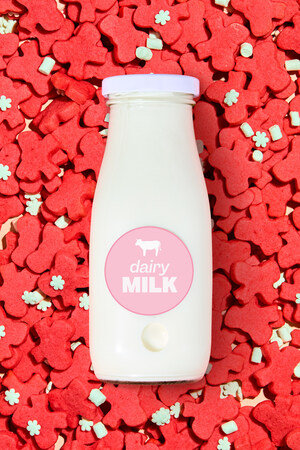WASHINGTON, Aug. 3, 2017 /PRNewswire/ -- From celebrity websites and diet books to popular Instagram feeds and clean eating blogs, it appears to be trendy to ditch dairy. A new survey from the National Osteoporosis Foundation (NOF) found six in 10 moms have tried or are currently restricting their intake of dairy. And, fewer moms encourage their kids to drink milk today than before – some are even restricting their child's intake of dairy.1 Experts say going dairy-free can have significant downfalls, especially for kids and young adults.
Is America Cutting Back on Dairy?
Unfortunately, too many kids today are growing up without drinking enough milk, and experts are alarmed because 66 percent of boys and 83 percent of girls do not meet the recommended intakes of milk during this critical time.2
America is drinking less milk today than ever before – about 10 gallons less per person per year since 1970, according to USDA availability per capita data. Yet, the reality is it's hard to get enough of nutrients you need without milk in your diet.3
"As a mom and a pediatrician, I'm incredibly concerned about the influx of dairy-free diets. Dairy alternatives don't have the same nutrients as dairy milk, and kids are not eating enough kale, spinach or sardines to replace the calcium in milk," said Dr. Tanya Altmann, pediatrician, best-selling author and nationally recognized parenting expert. "Missing out on nutrients like calcium and vitamin D during the critical bone-building years has very serious public health implications."
The good news is that many moms know how important milk is for their kids, according to the NOF survey. Moms choose milk for their kids because of the important nutrients milk provides like calcium, vitamin D and protein. In fact, more than 80 percent of moms know milk is nutrient-rich. They also know milk helps build strong bones and is important for their child's growth. Incorporating milk every day may be easier than many moms think: prior research shows that most kids like milk and would drink more of milk if it was served.4
The Health Impact of Going Dairy-Free
Cutting dairy could have serious consequences for young people. That's because there's a limited-time to build strong bones and then that window shuts. Many people are surprised to learn that bones continue to grow to their peak bone mass until your mid-20s, according to the NOF. Nutrition, including getting enough calcium and vitamin D, weight-bearing and muscle-strengthening exercise, along with other lifestyle factors, help children and adolescents achieve optimal bone health. According to NOF, a dairy-free diet during these critical growing years could mean not reaching their full height potential, an increase in stress fractures during adolescence, and a greater chance of osteoporosis as an adult.5,6,7,8,9,10
"Osteoporosis is a childhood disease with adult consequences," said Andrea Singer, MD, FACP, CCD, clinical director for the NOF. "Consuming recommended daily amounts of calcium and vitamin D from childhood through early adulthood is important to help achieve maximum bone strength. This is the point in time where bones are the strongest and most dense they're ever going to be."
In fact, milk is the top food source for three of the four nutrients of concern identified by the Dietary Guidelines – the nutrients Americans, including children, are most lacking: calcium, vitamin D and potassium.11
Growing Up Strong and Healthy
Decades of research and hundreds of studies support the benefits of milk. Not only does milk provide a unique package of nutrition and support strong bones, research suggests "intake of dairy products is also associated with a reduced risk of cardiovascular disease and type 2 diabetes, and with lower blood pressure in adults," according to ChooseMyPlate.gov.
"I encourage my kids to drink milk not only because it's nutrient-rich and farm fresh, but also because I know my kids love it. Plus, white milk has no sugar added and costs about a quarter per glass," said Dr. Altmann. "Smoothies are big in our house – I simply mix milk with yogurt, fruits and veggies in the morning for a delicious and nutritious start to the day."
For more information, including tips and recipes, visit milklife.com.
About MilkPEP
MilkPEP, Washington, D.C., is funded by the nation's milk companies, who are committed to ensuring all children have access to nutrient-rich milk. The MilkPEP Board runs the Milk Life campaign, a multi-faceted campaign designed to educate consumers about the powerful nutritional benefits of milk – with essential nutrients, including high-quality protein, in each 8 ounce glass. For more information, go to milklife.com. Campbell Ewald is creative agency for the Milk Life campaign – from America's milk companies.
| 1 |
National Osteoporosis Foundation (NOF) member-survey (July 2017) |
| 2 |
Krebs-Smith SM, Guenther PM, Subar AF, Kirkpatrick SI, Dodd KW. Americans do not meet federal dietary recommendations. Journal of Nutrition. 2010;140:1832-1838. |
| 3 |
Gao X, Wilde PE, Lichtenstein AH, Tucker KL. Meeting adequate intake for dietary calcium without dairy foods in adolescents aged 9 to 18 years (National Health and Nutrition Examination Survey 2001-2002). Journal of the American Dietetic Association. 2006;106:1759-1765. |
| 4 |
MilkPEP research with study of 2,400 moms and 1,500 kids. |
| 5 |
Wiley AS. Does milk make children grow? Relationships between milk consumption and height in NHANES 1999-2002. American Journal of Human Biology. 2005;17:425-441. |
| 6 |
Ruffing JA, et al. Determinants of bone mass and bone size in a large cohort of physically active young adult men. Nutrition & Metabolism. 2006;3:14. |
| 7 |
Rockell JE, Williams SM, Taylor RW, Grant AM, Jones IE, Goulding A. Two-year changes in bone and body composition in young children with a history of prolonged milk avoidance. Osteoporosis International. 2004;16:1016-1023. |
| 8 |
Goulding A, Rockell JE, Black RE, Grant AM, Jones IE, Williams SM. Children who avoid drinking cow's milk are at increased risk for prepubertal bone fractures. Journal of the American Dietetic Association. 2004;104:250-253. |
| 9 |
Morency M, Birken CS, Lebovic G, Chen Y, L'Abbé M, Lee GJ, Maguire JL and the TARGet Kids! Collaboration. Association between noncow milk beverage consumption and childhood height. American Journal of Clinical Nutrition. 2017. [Epub ahead of print]. |
| 10 |
Weaver CM, Gordon CM, Janz KF, Kalkwarf HJ, Lappe JH, Lewis R, O'Karma M, Wallace TC, Zemel BS. The National Osteoporosis Foundation's position statement on peak bone mass development and lifestyle factors: a systematic review and implementation recommendation. Osteoporosis International. 2016;27:1281-1386. |
| 11 |
U.S. Department of Health and Human Services and U.S. Department of Agriculture. 2015 – 2020 Dietary Guidelines for Americans. 8th Edition. December 2015. |
Contact:
Natalie Soper
[email protected]
SOURCE MilkPEP
Related Links
WANT YOUR COMPANY'S NEWS FEATURED ON PRNEWSWIRE.COM?
Newsrooms &
Influencers
Digital Media
Outlets
Journalists
Opted In






Share this article